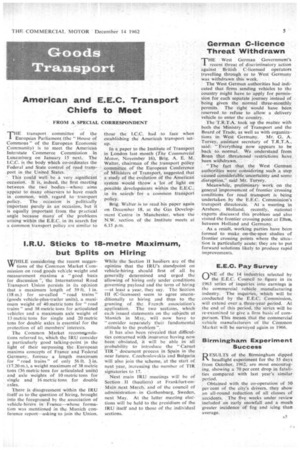Sticks to 18-metre Maximum, but Splits on Hiring
Page 7

If you've noticed an error in this article please click here to report it so we can fix it.
WHILE considering the recent suggesIry tions of the Common Market Commission on road goods vehicle weight and measurement maxima a "good basis for discussion ", the International Road Transport Union persists in its opinion that a maximum length of 59 ft. 1 in. 118 m.) for so-called "road trains" (goods vehicle-plus-trailer units), a maximum weight of 40 metric tons for " road trains " and 38 metric tons for articulated vehicles and a maximum axle weight of 13 metric tons for single and 20 metric tons for double axles is essential for the protection of all members' interests.
The Common Market recormwndations referred to, which the IRU consider a particularly good talking-point in the light of their surpassing the European maxima concepts or France and Federal Germany, foresee a length maximum for "road trains" of only 56 ft. 3 in. (17.20 m.), a weight maximum of 38 metric tons (36 metric tons for articulated units) and axle weights of 10 metric tons for single and 16 metric tons for double axles.
There is disagreement within the IRU itself as to the question of hiring, brought into the foreground by the association of vehicle-hirers in France—whose formatkin was mentioned in the Munich conference report—asking to join the Union.
While the Section II hauliers arc of the opinion that the IRU's standpoint on vehicle-hiring should first of all be generally determined and urged the allowing of hiring only under conditions governing payload and the term of hiring —at least a year, they say. The Seetion III (C-licensees) seem to agree unconditionally to hiring and thus to the granting of the French _association's application. The two 'sections, which each issued statements on the subjects at Munich in May, will now have to " consider sepai'ately their fundamental attitude to the problem ".
It has also been revealed that difficulties concerned with insurance having now beest obviated, it will be able in all probability to introduce the Carnet TIR " document process in Spain in the near future. Czechoslovakia and Bulgaria will also join the scheme, at the stai't of next year, increasing the number of TIR signatories to 17.
Next main IRU meetings will be of Section . II (hauliers) at Frankfurt-onMain next March: and of the council of administration in Gothenburg, Sweden, next May. At the latter meeting eleetions will be held to the presidium of the IRU itself and to those of the individual sections.




















































































































